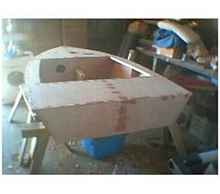This started as an exercise to see if I could build a brand new
boat very cheaply for my 5 year old son. After looking around
at the other existing designs here in New Zealand, I came to a
couple of conclusions the first being that all the existing designs,
although most come with detailed plans, are far to complicated
for the unskilled home handy man to build. The second was that
although the others were established they appeared a little dated
in appearance. So after establishing these things, I began to
develop some conceptual ideas. The first was that the boat had
to be able to be built with a minimal amount of skill. Next, it
had to be as cheap as was possible. Third, it had to have a fairly
modern appearance. Having established these basic parameters,
I developed some other basic necessities - displaced weights and
what I was going to build it from. Displacement meant that it
would carry a child from 20 kilograms through to around 50 kilograms.
I then decided that sheet marine plywood was the answer, so I
designed a 2.4 meter sharpie style hull with a straight stem and
a reverse sheer.
I began by purchasing 3 sheets of 4mm meranti ply wood and one
6mm sheet and some 3 meter length of cedar timber. I set up my
skill saw and ripped some of the 100 x 50mm timber into 10mm x
50mm lengths (better if you know some one with a saw bench to
do this). I then drew the 2 frames and the transom onto a sheet
of the plywood and cut them out. I then used the cedar timber
to glue onto each edge of each frame and clamped them all on.
I used epoxy resin with a glue additive. The next day I cleaned
up the frames and fashioned 2 jig bearers out of some old 100
x 50 mm framing timber I had laying around. The jig bearers formed
an A frame style to a length of 2.4 meters. Next, I stood the
frames up and transom up at their appointed positions on the jig,
made sure they were vertical and cut the checkouts for the Keelson.
Remember we are only on day 2 here. I next cut a piece of timber
for the bow post shaped it to approximately the correct vee shape
and glued the keelson and bow post in and left it to go off over
night. The next day ,day 3, I could see the boats shape beginning
to appear. I cut the checkouts for the Chines and Gunwales and
glued them in day 4. I cut the side panels out and these are a
little longer than a 2.4 meter sheet of plywood, so at the transom
end I had to make a small piece and join it on with a backing
plate behind. I then glued both side panels on.
By now we really have a reasonable idea of what it is beginning
to look like and it just looks fast and modern. Day 5 and its
time to clean off the chines at the bottom to fit the whole bottom
panel. This is one sheet and is glued on in a single go. This
takes a while. I nailed it on with holdfast angular nails at about
75mm centres. On day 6 I cleaned off all the excess plywood from
around the hull, removed the jig and sat it up the right way on
2 saw horses.
 |
Cleaned and on saw horses. |
Now I had a boat I could totally see. The next job was to fashion
the mast support. I put that and the king plank in all in one
go. I put the chainplate doublers in and glued them in all in
one go. I made the centre case. Next task was to glue the deck.
This, like the bottom, goes on all in one go and I glued the centre
case in as well. Basically, the boat apart from paint and fittings
is finished.
| View of transom |
 |
So next we sanded and painted. I asked the young one what colour
he wanted. I first varnished the deck and painted the hull. I
rang a friend who was a sail maker and ordered a sail and organised
an aluminium mast. Another constructed a rudder and a centreboard
and we put it on with minimal fittings and we had a 2.4 x 1.2
meter small sailboat.
 |
Rigged and tried on for size. |
It is modern in appearance, light and simple. The telling thing
would be how would it sail. I could not let young Tim loose on
his own with no experience, so I decided I better get in it with
him. I was a little apprehensive as I had not designed it to carry
an extra 90 kilograms of weight, but the hull form handled it
admirably and the boat sailed beautifully. Several tacking sessions
up and some good quick runs down a New Zealand sheltered beach
confirmed everything I had thought.
Although some thought it would not be a good concept, a teenage
boy approached me at a local beach showing interest and when I
explained what I had done and that it was all new for around $1100,
he said that he thought it was great and could not believe the
weight of the complete boat as he helped me out of the water.
It's a success, I thought, as it created interest in the youth
of today, who are experienced young sailors.
| Ready for young sailors. |
 |
I have since drawn up detailed plans if anyone was interested
in building the boat.
Allan Roper
Allan.roper@vodafone.co.nz
*****

|

